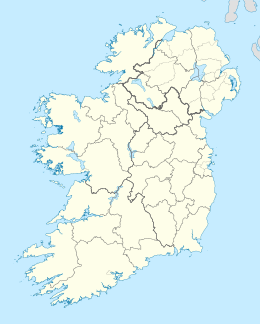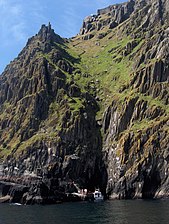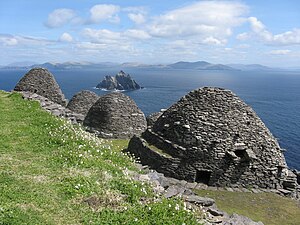geo.wikisort.org - Island
The Skellig Islands (Irish: Na Scealaga), once known as "the Skellocks",[1] are two small, steep, and rocky islands lying about 13 km (8 mi) west of Bolus Head on the Iveragh Peninsula in County Kerry, Ireland. The larger of the two is Skellig Michael (also known as Great Skellig) which, together with Little Skellig, is at the centre of a 364-hectare (899-acre) Important Bird Area established by BirdWatch Ireland in 2000.[2] Skellig Michael is also famous for an early Christian monastery that is a UNESCO World Heritage Site.
 Little Skellig, as seen through the window of a hermitage on Skellig Michael | |
 Skellig Islands | |
| Geography | |
|---|---|
| Location | Atlantic Ocean |
| Coordinates | 51°46′N 10°32′W |
| Total islands | 2 |
| Major islands | |
| Administration | |
Ireland | |
| County | Kerry |
| Demographics | |
| Population | 0 |
Little Skellig
The smaller of the two islands is Little Skellig (Sceilig Bheag in Irish).[3] (grid reference V268618) It is Ireland's largest northern gannet (Morus bassanus) colony with almost 30,000 pairs, and is closed to the public. It is also one of the world's largest northern gannet colonies, and is of international importance.[4] The island is 134 m (440 ft) tall and is approximately 1.5 km (1 mi) east-northeast of Skellig Michael.
Skellig Michael
Also known as Great Skellig (Sceilig Mhichíl in Irish[5]), this is the larger of the two islands, with two peaks rising to over 230 m (750 ft) above sea level. With a sixth-century Christian monastery perched at 160 m (520 ft) above sea level on a ledge close to the top of the lower peak, Great Skellig is designated as a UNESCO World Heritage Site.
Birdwatch Ireland were concerned that the Irish government allowed filming on a seabird sanctuary without third party consent. During the 2014 nesting season, black-legged kittiwake chicks in nests were swept into the sea by the downdraught from a helicopter and devoured by gulls.[6][7]
Wildlife
Both of the Skellig islands are known for their seabird colonies, and together compose one of the most important seabird sites in Ireland, both for the population size and for the species diversity. Among the breeding birds are European storm petrel (Hydrobates pelagicus), northern gannet, northern fulmar (Fulmarus glacialis), Manx shearwater (Puffinus puffinus), black-legged kittiwake (Rissa tridactyla), common guillemot (Uria aalge), razorbill (Alca torda) and Atlantic puffin (Fratercula arctica) (with 4,000 or more puffins on Great Skellig alone). Red-billed chough (Pyrrhocorax pyrrhocorax) and peregrine falcon (Falco peregrinus) can also be seen.[8]
The surrounding waters have abundant wildlife with many Grey seal (Halichoerus grypus). Basking shark (Cetorhinus maximus), minke whale (Balaenoptera acutorostrata), dolphin (Delphinidae), beaked whale, and leatherback sea turtle (Dermochelys coriacea) have also been recorded. The islands have many interesting recreational diving sites due to the clear water, an abundance of life, and underwater cliffs down to 60 meters (200 feet).
Filming location
The final scene of Star Wars: The Force Awakens was shot on Skellig in July 2015, with additional filming taking place there in September 2015 for The Last Jedi, the following film in the series. The remains of the Skellig Michael monastery appear in the film, representing an ancient Jedi temple.[9][10]
Earlier, the Skellig Islands served as a location in the Werner Herzog 1976 movie Heart of Glass, where the islands feature in one of the prophecies by the seer Hias.[11]
Certain scenes from the 2012 movie Byzantium were also filmed here.[12]
Gallery
- View of Skellig Michael
- SE landing on Skellig Michael
- Beehive style huts on Skellig Michael
- Northern gannet colony on Little Skellig
References
- Analecta Hibernica. Stationery Office of Saorstát Éireann. 1995. p. 332.
- BirdWatch Ireland. "The Skelligs: Great Skellig and Little Skellig". BirdLife International. Retrieved 28 January 2017.
- logainm.ie
- "Little Skellig, Co. Kerry". BirdWatch Ireland. Retrieved 19 September 2015.
- logainm.ie
- Star Wars: Habitats directive ‘breached’ on Skellig Michael, The Irish Times, 17 December 2015
- "Jedi threat to seabirds". New Scientist. 227 (3039): 7. 19 September 2015.
- "Skelligs SPA (IE0004007)". Natura 2000. European Environment Agency. Retrieved 9 October 2022.
- O'Sullivan, Majella (29 July 2014). "And . . . action! New 'Star Wars' film shoot kicks off on Skellig Michael". Irish Independent. Independent News & Media. Retrieved 29 November 2014.
- "BirdWatch Ireland has major concerns over Star Wars filming on Skellig Michael". BirdWatch Ireland. 8 September 2015. Retrieved 19 September 2015.
- "Heart of Glass (1976) Filming Locations". Retrieved 28 April 2017.
- Byzantium (2012), retrieved 14 June 2017
External links
- UNESCO World Heritage Centre – Skellig Michael
- A Project Web Site about The Skellig Islands
- Virtual reality accessibility Project for e-learning and people with limited mobility by Burger Landmarks
На других языках
- [en] Skellig Islands
[es] Islas Skellig
Las Islas Skellig (en inglés, Skellig Islands; en gaélico irlandés, Na Scealaga) son dos pequeñas y empinadas islas rocosas que se sitúan a unos 16 km al oeste de la península de Iveragh, en el Condado de Kerry, Irlanda. Son famosas por sus poblaciones de frailecillos y alcatraces, así como por un antiguo monasterio cristiano que ha sido declarado Patrimonio de la Humanidad por la Unesco.[fr] Îles Skellig
Les îles Skellig (en irlandais : Na Scealaga) sont un archipel de la côte sud-ouest de l'Irlande, formé des îles de Skellig Michael et Little Skellig. Elles se situent plus précisément au large de la péninsule d'Iveragh, dans le comté de Kerry dans la province du Munster.[it] Isole Skellig
Le Isole Skellig (Skellig Islands o Skellig Rocks, talvolta abbreviato Skelligs, in inglese; Oiléain na Sceilig in gaelico irlandese ) sono due piccoli isolotti impervi al largo delle coste del Kerry, contea sud-occidentale della Repubblica d'Irlanda.[ru] Скеллиг (острова)
Острова Скеллиг (ирл. Na Scealaga[3], англ. The Skelligs) — два маленьких скалистых острова, Литл Скеллиг (англ. Little Skellig) и Скеллиг-Майкл (англ. Skellig Michael), у полуострова Ивера в графстве Керри. Известны своей популяцией северных олуш, атлантических тупиков и раннехристианским монастырём, включённым во Всемирное наследие ЮНЕСКО[4].Другой контент может иметь иную лицензию. Перед использованием материалов сайта WikiSort.org внимательно изучите правила лицензирования конкретных элементов наполнения сайта.
WikiSort.org - проект по пересортировке и дополнению контента Википедии




